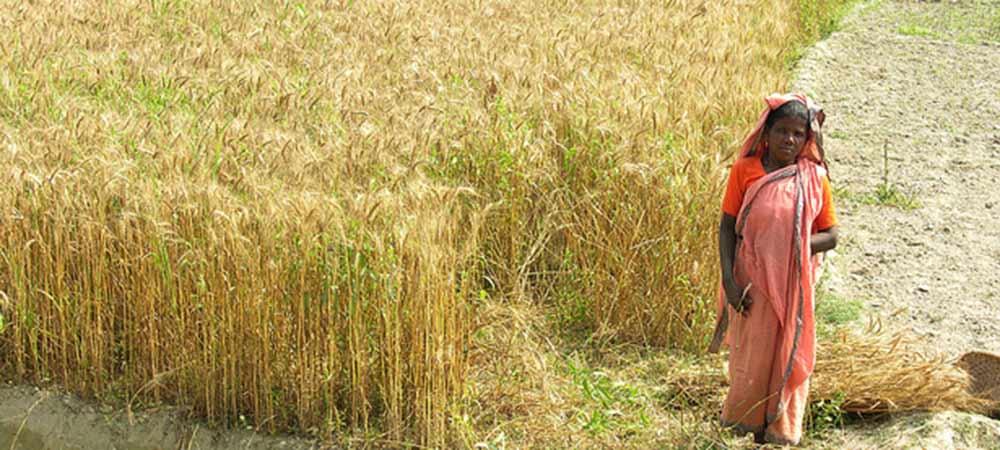
Dear EarthTalk: Is it true that global warming is causing our crops to be less nutritious? — William Persson, Glendale, OH
It is difficult to say whether or not the climate change we are now experiencing is negatively impacting the nutritional quality of our food, researchers warn that it may be only a matter of time. “Humanity is conducting a global experiment by rapidly altering the environmental conditions on the only habitable planet we know,” reports Samuel Myers, a research scientist at the Harvard School of Public Health.
Earlier this year, Myers and his colleagues released the results of a six-year study examining the nutritional content of crops exposed to levels of atmospheric carbon dioxide (CO2) that are expected to exist by mid-century. The conclusions were indeed troubling. They found that in wheat grains, zinc concentrations were down some 9.3 percent and iron concentrations were down by 5.1 percent across the seven different crop sites (in Australia, Japan and the U.S.) used in the study. The researchers also noted reduced protein levels in wheat and rice grains growing in the CO2-rich test environment.
According to Myers, the findings — published in June 2014 in the peer-reviewed journal Nature — are particularly troubling when one considers that some of the two to three billion people around the world who depend on wheat and rice for most of their iron and zinc already might not be getting enough of these essential nutrients. Zinc deficiency, which can exacerbate pneumonia, malaria and other health problems, is already linked to some 800,000 deaths each year among children under five. Meanwhile, iron deficiency is the primary cause of anemia, a condition that contributes to one in five maternal deaths worldwide.
Myers and company aren’t the only ones worried about global warming and nutrient losses. Another recent study by mathematical biologist Irakli Loladze analyzed data from thousands of “free-air CO2 enrichment experiments” on 130 different species of food plants and found that increased CO2 reduced overall mineral (nutrient) content across the board. “People don’t need large quantities of the manganese or potassium they get from plants, but they do need some,” comments David Berreby on BigThink.com in response to Loladze’s findings. “And for billions of people, plants are their only source.”
Berreby is also bothered by another of Loladze’s conclusions, that higher levels of CO2 also spur increases in starches and sugars in the same plants that lose mineral content. “In other words, with increases in atmospheric carbon dioxide, the valuable nutrients in these food crops are scarcer, and carbohydrates are more abundant — in effect, the nutrients are ‘diluted,'” he explains. This syncs with research out of the University of California at Davis, which estimates that the overall amount of protein we get from our food plants will drop some three percent in the coming decades given global warming’s expected arc.
While dramatically reducing our CO2 emissions would be the best way to stave off nutrient losses in our crops, we do have some other options just in case we don’t get our act together regarding fossil fuel consumption. Myers suggests that breeders and genetic engineers could develop new strains of crops designed to be less sensitive to atmospheric CO2 levels and/or higher in mineral content to begin with. Regardless, upping the amount of fruits and vegetables in our diets — perhaps more easily said than done — may be more important than ever in our carbon-intensive world.
CONTACTS: Harvard School of Public Health, www.hsph.harvard.edu; BigThink, www.bigthink.com Photo: A woman in a rice field in Bangladesh. Credit: Peter Fredenburg, courtesy Flickr.

Sweden topped the recently released environmental sustainability ranking of 60 countries by the Global Green Economy Index. The rankings take into account a wide range of key issues, including leadership on climate change, green technology and sustainability, and management of ecosystems and natural capital. Pictured: A display greets visitors to the Swedish Embassy in the United States.
It’s true that Sweden came out on top in the recently released ranking of 60 countries according to sustainability by consulting firm Dual Citizen Inc. in its fourth annual Global Green Economy Index (GGEI). Norway, Costa Rica, Germany and Denmark rounded out the top five. The rankings take into account a wide range of economic indicators and datasets regarding leadership on climate change, encouragement of efficiency sectors, market facilitation and investing in green technology and sustainability, and management of ecosystems and natural capital.
Sweden’s first place finish reflects the Swedes’ ongoing commitment to climate change mitigation and sustainability policies and practices. The country is a leader in organic agriculture and renewable energy as well as per capita investment in green technology and sustainability research. Upwards of 75 percent of Swedes recycle their waste, while only 4 percent of the country’s garbage goes to landfills. In fact, Sweden imports garbage from other nations to burn as a renewable source of energy.
On the climate front, Sweden was one of the first countries in the world — going back to 1991 — to put in place a heavy tax on fossil fuels to encourage the development of greener sources of energy. Indeed, the high price of gas there has notably boosted sales and consumption of homegrown, renewable ethanol. Just a few decades ago Sweden derived 75 percent of its energy from fossil fuels, but is on track to shrink that to 18 percent by 2020, with many Swedes clamoring for the country to abandon fossil fuels entirely at that point. As if that wasn’t enough, Sweden recently announced that it would pay a whopping $500 million over the next four years into the United Nations’ Green Climate Fund, a pool of money sourced from richer countries to help poorer ones transition to a future less dependent on polluting fossil fuels.
The United States didn’t fare so well in the GGEI, ranking just 28th overall, just behind Rwanda and slightly ahead of Canada. Despite leadership in green technology and environmental awareness, Americans’ disproportionately large carbon footprint and resistance to a national policy on climate change mitigation are hurdles to the U.S. achieving a better ranking.
The GGEI isn’t the only sustainability ranking of countries. The Yale Center for Environmental Law & Policy and Columbia University’s Center for International Earth Science Information Network recently released their 2014 Environmental Performance Index (EPI), a similar but more expansive ranking of 178 nations on environmental health and ecosystem vitality. Switzerland topped that list, followed by Luxembourg, Australia, Singapore and the Czech Republic. Sweden ranked 9th and the U.S. 33rd.
The fact that global rankings like the GGEI and EPI exist shows without a doubt that sustainability concerns are a global phenomenon, and that people from Iceland to Australia (two highly ranked countries) realize the importance of taking care of Mother Earth. Despite issuing different rankings, both indices had a lot in common, with five countries (Norway, Germany, Switzerland, Austria and Spain) making the top 10 list of each. Another common conclusion was that the U.S. has much to do if it hopes to be taken seriously among world leaders committed to protecting the planet and our common future.
CONTACTS: GGEI 2014, dualcitizeninc.com/GGEI-Report2014.pdf; EPI, epi.yale.edu.
 Dear EarthTalk: Is it true that playing on artificial turf fields can cause cancer? If so, how can I minimize exposure for my sports-loving kids? — Melanie Witmer, Syracuse, NY
Dear EarthTalk: Is it true that playing on artificial turf fields can cause cancer? If so, how can I minimize exposure for my sports-loving kids? — Melanie Witmer, Syracuse, NY
Just when you thought it was safe to play soccer on that brand new synthetic turf field, it may be time to think again. Those little black dirt-like granules that fill up the space between synthetic blades of grass and make up some 90 percent of today’s artificial turf fields are actually ground-up car and truck tires. As such they contain a host of potentially noxious chemicals that can lead to a wide range of health problems.
Four of the constituent chemicals in these “tire crumbs” (or “tire mulch”) as they are called — arsenic, benzene, cadmium and nickel — are deemed carcinogens by the International Agency for Cancer Research. Others have been linked to skin, eye and respiratory irritation, kidney and liver problems, allergic reactions, nervous systems disorders and developmental delays.
While the risk came to light recently when a University of Washington women’s soccer coach began to think it might be more than a coincidence that two of her goalies were stricken with cancer, researchers have known about such potential links for years. A 2007 report by the Connecticut-based Environment & Human Health Inc. (EHHI) looked at several scientific studies and found definitive connections between various health problems and exposure to synthetic turf.
EHHI also reported that kids on playfields are likely to face similar risks as line workers in the rubber fabrication and reclamation industries, where they say health reports show the presence of multiple volatile organic hydrocarbons and other toxic elements in the air. “Studies at tire reclamation sites report leaching of similar sets of chemicals into the ground water,” says the group.
The Synthetic Turf Council, an industry group, maintains that there is considerable evidence pointing to the health safety of synthetic turf. But the U.S. Environmental Protection Agency (EPA) isn’t taking sides, leaving it up to state and local jurisdictions to decide whether or not to allow artificial turf. The EPA would like to see more research done so parents everywhere can have a better idea of the risks involved.
Of course, synthetic turf fields aren’t all bad. For one, they don’t need frequent watering (a grass playing field typically requires 50,000 gallons of water per week during growing season) and doesn’t require the application of potentially toxic pesticides. Furthermore, turf is much more durable and less costly to maintain than grass, and players suffer fewer injuries on it since it doesn’t turn to slippery mud when wet.
Do these pros outweigh the cons? Some schools don’t think so and are turning back plans to convert their grass fields to turf. Where it is too late for that, parents should warn their little athletes to stay upright as much as possible — turf-related cancers seem to be most common in goalies who spend the most time down on the turf surface. Also, the Centers for Disease Control and Prevention (CDC) recommends that those playing on synthetic turf avoid eating or drinking on the field where toxic dust can contaminate food and liquids, wash their hands and body aggressively with soap and water afterwards, and remove clothes worn on the field and turn them inside out before washing them separately from other items.
CONTACTS: International Agency for Cancer Research, www.iarc.fr; EHHI, www.ehhi.org; Synthetic Turf Council, www.syntheticturfcouncil.org; CDC, www.cdc.gov.

Studies have concluded that American kids consume very few fruits and vegetables in their school cafeterias and that they are eating many refined grains and too much saturated fat and sodium. In addition, a 2009 USA Today study found that meat used by McDonald’s and Burger King was tested for bacteria and unsafe pathogens up to 10 times as much as meat bound for U.S. school cafeterias.
Americans have done a great job making sure that our kids have something to eat at school regardless of socioeconomic status, with the National School Lunch Program providing low-cost or free lunches to upwards of 31 million students at 92 percent of U.S. public and private schools.
But that doesn’t mean the food has been especially nutritious, and public health experts say it’s no wonder our kids are more obese than ever when we feed them trans fats, salts and sodas for lunch. Kids get half their daily calories at school, so what’s for lunch there has a big impact on health and lasting eating habits.
A 2008 analysis of school lunches by the Institute of Medicine (IOM) concluded that American kids consume very few fruits and vegetables in their cafeterias — with potatoes accounting for a third of all vegetables consumed. IOM also found that kids were eating many refined grains and too much saturated fat and sodium. A 2009 study by USA Today found that meat used by McDonald’s and Burger King was tested for bacteria and unsafe pathogens up to 10 times as much as meat bound for U.S. school cafeterias.
In response to these stark findings, along with vigorous advocacy by First Lady Michelle Obama, things are starting to improve. In 2010, Congress voted to revamp the nation’s school lunch program by enacting the Healthy, Hunger-Free Kids Act (HHFKA). The higher standards in the new law seek to align school meals with the federal 2010 Dietary Guidelines for Americans by upping the availability and portion sizes of fruits, vegetables and whole grains (and requiring students to select a fruit or vegetable), establishing calorie ranges, removing trans fats and limiting sodium levels. The law also incentivizes schools to take part with generous meal reimbursement funds. The new standards went into effect in 2012 and have been working their way through school districts from coast-to-coast and getting rave reviews in the process.
Researchers from the Harvard School of Public Health who collected plate waste data among more than 1,000 students in four schools in urban, low-income school districts both before and after HHFKA took effect found that fruit selection increased 23 percent following implementation: “Average per person fruit consumption was unchanged,” said researchers, “but because more students selected fruit overall, more fruit was consumed post-implementation.” Also, per student vegetable consumption went up 16.2 percent.
But just because public health researchers think the program is going well doesn’t mean Congress will keep it going. The Republican-dominated House of Representatives has included waivers for school lunch nutrition standards in its fiscal-year 2015 Agriculture Appropriations bill. “The provision would allow schools with a 6-month net loss of revenue to opt out of providing the healthier meals outlined by the HHFKA,” Dr. Jennifer Woo Baidal writes in the New England Journal of Medicine. “A deficit of any amount from any cause could allow schools to return to the same meals that the IOM found in 2008 to be nutritionally lacking.” Consumers interested in protecting the new nutritional standards should weigh in by calling, writing or e-mailing their Congressional representatives and speaking up for healthier kids.
CONTACTS: National School Lunch Program, www.fns.usda.gov/nslp/national-school-lunch-program-nslp; IOM, www.iom.edu; HHFKA, www.fns.usda.gov/initiative/hhfka.









